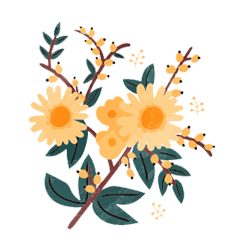Beyond Design: 12 Everyday Responsibilities of Floral Designers
Every individual aspiring to live the creative life of a floral designer has the same doubts. What does the job of a floral designer actually look like? And Do I have the right skills and capacity to be one?
These are frequently asked questions. This article is all about helping you understand a floral designer’s actual, everyday roles and responsibilities. Keep reading to gain an in-depth insight into what the day in the life of a floral designer actually includes – from designing to accounting to everyday travels.
1. Flower Care
Floral designers must attend to different types of flowers and water, condition, and nurture them as needed. This makes up a large part of their job as it determines the final quality of their flowers; the size, vibrance, and lifespan.
It includes caring for the petals, stems, and surrounding leaves as well. They must learn the different growth needs of different indoor and outdoor plants to deliver the right care every day.
2. Flower Preservation
If a flower is not cut the right way and held in the right material, it will deteriorate quickly. Preservation is all about prolonging the lifespan and health of flowers once they are cut and delivered to the client. This includes a lot of conditioning and using the appropriate arrangement and cutting techniques.
3. Creating Designs
This is a no-brainer, but there is more to designing than what meets the eye. Floral designers must come up with new unique ideas that satisfy the client’s vision, are well within the client’s budget, and adhere to their quality standards.
Every floral arrangement requires a different type of spacing, alignment, and sizing of flowers. Moreover, color blending and coming up with a visually pleasing color palette is also a responsibility. This process isn’t straightforward but comes with a lot of trial and error and experimentation.
4. Finding Inspiration
Floral design is an ever-changing industry where the client’s tastes and preferences change every day.
Floral designers have to keep up with different trends, such as the newest color palettes, flower types, and arrangements in style. This involves staying active in the community, following large floral design brands, reading blogs and magazines, and conducting their own experiments.
There is a lot to take into consideration when finding inspiration. Floral designers must consider their local market’s tastes, the availability of flowers, and relevance to their niche before proceeding with an inspiration.
5. Quality Assessment
At the end of the day, floral designers work as a business with certain standards of quality and customer experience. Every day, they must inspect each flower’s health and quality before using it in a design.
Once the design is finished, it undergoes another quality assessment to ensure that everything is placed correctly and not prone to misplacement during delivery.
The process can look different for each floral designer, depending on the specific floral pieces they work with. The quality assessment for a corsage or garland may be more extensive than that of bouquets and so on.
6. Supply Management
Floral designers must maintain enough inventory of every flower in continual need. They regularly track the ins and outs of each flower, the current and future needs of each style, and send out inquiries to different supplies.
In some cases, this involves a regular visit to the local farmer’s market and securing a cost-effective deal. When working on an event, the designer has to create a list of flowers, decorations, leaves, and other hardware needed.
Along with procuring the right supplies, they also need to ensure that they can accommodate everything within the client’s budget.
7. Client Consultation
Floral designers don’t create everything however they want; it is all about the client’s wishes. While some clients are open to suggestions and go with whatever their floral designer has to offer, most already have a clear vision.
Floral designers consult their clients regarding the colors, styles, and variety they want in their event. This can include picture references as well. Budget is also a common subject of such consultations.
Floral designers communicate their prices— how much work they will do for a certain budget. When rare flowers or arrangements are included, designers often have to contact different suppliers to find the rate for their clients.
8. Accounting
This is an often overshadowed aspect of running a floral design business. Floral designers must keep track of all costs of the business. This includes flowers, leaves, decoration, hardware tools (wires, glues, thorn strippers), and packaging material. They also have to maintain financial records for each event they complete, including the delivery costs, traveling costs, and other accommodation costs.
9. Packaging
It’s no secret that flowers are prone to damage even with the slightest disruptions. Floral designers must ensure adequate protective packaging for different arrangements, including bouquets, corsages, and wreaths.
Ordering and using the right sizes of boxes, foams, and baskets make an important part of their job.
10. Organization
Like every other decoration and design task, floral designing also demands superior time and material management.
Floral designers often work on strict deadlines and have to prepare for events in a single day. They have to prepare every flower, turn them into the right arrangements, deliver it to the destination, and settle it in different places in the venue.
11. Billing
Once everything about an event is taken care of, floral designers must accurately list down all the services and arrangements they delivered. They create a bill for every floral order and prepare it for sign-off by the clients. This requires an accurate assessment of each and every material that went into the project.
12. Traveling
Floral designers travel a lot to find the perfect deals and a variety of flowers.
Visits to the farmer’s market are very common. Some designers may visit it more than once a day, depending on the flow and needs of clients. They also attend local events and workshops in the community to stay updated with the progress in their local floral design market.
Conclusion
Floral designers have a lot in common with entrepreneurs— they have to strike the perfect balance between being creative, time-savvy, and cost-efficient. Along with designing, their jobs are marked by flower care and conditioning. It’s important to remember the accounting and supply chain side of a floral design business. If you are someone who aims to run one, you must also improve your numbers game.




